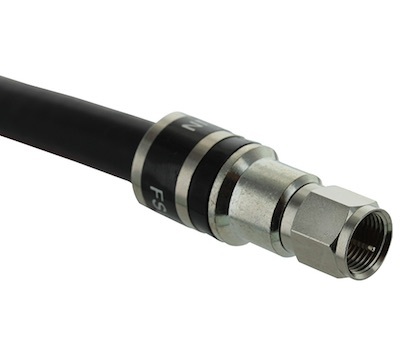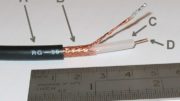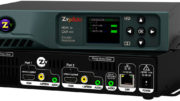Thanks to Signal Pro Rob Young for inspiring this article!
You’ve probably heard of RG11 cable. It’s like the common RG6 cable you’ll find connecting everything from satellite TV to cell boosters to internet. I’ve written before about how you should use RG6 cable with a solid copper center conductor whenever you think that cable might carry current as well as signal. It’s good advice for all cables, but the problem is that RG11 cable with a solid copper center conductor is pretty hard to find. So why is this?
First, a little bit about RG11 cable
RG11 cable is coaxial cable on steroids. It’s designed for longer runs, and it has on average about 33% less loss than RG6 cables. This should mean that you can run 33% further and have the same amount of loss. It’s used for long cable runs whenever putting an amplifier in wouldn’t work.
RG11 cable performs this magic through simple physics. Everything about the RG11 cable is super-sized. Every component has extra material so that signals move more freely. The result, though, is a cable that’s no only much thicker than RG6 cable but also much stiffer. This makes it a lot harder to work with. Even simple curves that RG6 can traverse easily are difficult for RG11. Most of the time, it’s not worth using RG11 within a home just because it’s such a pain.
But the real reason is something very specific.
Now, this next part is surprisingly controversial. I’ve had RF Engineers tell me I’m wrong, but all I’m going to tell you is what I was told.
As a rule, you should never have RG11 cables that are shorter than 100 feet. Compare that to the rule of thumb that says you shouldn’t have RG6 cables shorter than 2.5 feet. The reason comes down to the way signals flow through the connectors.
You can think of the connector on the end of a cable sort of like the drain in your sink. It’s a transition point between the cable and… something else. (It doesn’t matter what, really.) As you run water in the sink, it doesn’t go straight down the drain. Some of it hits the side of the drain and splashes. Believe it or not, signals going through a cable act much the same way. They hit the edge of the connector and bounce back into the cable. The result is what’s called a “reflection.” This reflection causes a small amount of signal to head back in the other direction. This is one of the main sources of loss as you exit a cable.
This reflection dissipates and doesn’t hurt anyone… until it does. If a reflection from one side of a cable hits a connector on the other side of the cable, a second reflection is created. That second reflection heads back in the same direction as the original signal and causes a lot of interference. So, you just plain don’t want that to happen.
Avoiding reflection problems in cables
Typically speaking, the reflections in RG6 cables dissipate after about 11 inches or so. So, you’re fine as long as you have a cable longer than that. Because reflections happen on both sides when signals are traveling in both directions, the rule of thumb is that your cable should be more than twice the length of the reflections. So, a 2.5 foot RG6 cable is the minimum if you want to avoid problems.
Then there are RG11 cables. Because of their superior build quality, reflections can travel further. A LOT further. It’s possible for reflections to continue on RG11 for over forty feet before dissipating. So, as a rule, we say that RG11 cable should never be shorter than 100 feet in order to keep reflection problems to a minimum.
And this affects the center conductor… how?
Here’s where it all comes together. The only reason to have a solid copper center conductor is to carry current (for example to power a dish or an amplifier.) Solid copper is much more expensive than copper-clad steel, which works just as well when you don’t need to power anything.
There’s one more general rule to consider. If you’re going to power something over coaxial cable, that cable should always be shorter than 100 feet. (Sometimes, the rule is to make these cables no longer than 50 feet.) Why? Depending on the amount of power we’re talking about, the voltage on the cable can drop by 33% over 100 feet. This is generally enough of a drop that you won’t be able to power the thing you were trying to power.
So…
Here’s the bottom line:
- Cables carrying current should always be under 100 feet.
- RG11 cables should NEVER be under 100 feet.
- You only need solid copper if the cables carry current.
Therefore, RG11 cables should never have current on them, because they’re always over 100 feet. This means copper-clad steel is generally fine for them.
Get the cables you need with a side order of good advice
If you’re looking for custom or specialty cables, call the experts at Solid Signal! We’re here for you during East Coast business hours and we have trained technicians ready to answer your questions. Call us at 888-233-7563 or fill out the form below!




